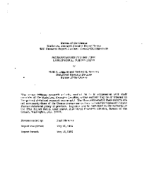Methodologies for Imputing Longitudinal Survey Items
Methodologies for Imputing Longitudinal Survey Items
Introduction
For each wave of a longitudinal survey, non-response may occur in one of two basic forms: wave nonresponse where the respondent answers no questions for the entire wave interview and item nonresponse where the respondent answers some questions but not all.
Wave nonresponse for a longitudinal survey is different from unit nonresponse for a cross-sectional survey. For the latter, typically the only variables available are those from sample frame data and interviewer notes. But because a longitudinal survey is conducted over time, the values of some variables, such as demographic variables, are available from earlier waves and are not expected to change much. These presumed known values can be used to contribute to the resolution of missing data values. Even more important, for a missing variable one may have access to values of this variable and other correlated variables as reported in other waves (longitudinal patterns). In some cases, these two factors can contribute to a reasonable resolution of missing values for wave nonresponse, and this sort of option is not usually available for cross-sectional surveys.
The focus of this report is an initial study of the imputation of missing items in a longitudinal survey. For a given variable, a respondent can report its value for every time period over a given wave, for none or some. Some variables are wave variables, some monthly, and some are weekly. Missing data in SIPP and ISDP result from noncoverage, household nonresponse, person nonresponse, record nonresponse and item nonresponse. Noncoverage occurs when some units in the survey population are not included in the sampling frame. Household nonresponse occurs when no data are reported for any household members. Person nonresponse results when data are not collected for one or more persons in an otherwise cooperative household. Item nonresponse occurs when some but not all the data are missing for a person. This may consist of individual westions (items) being unanswered or of whole sets of questions (record types) being unanswered. For item nonresponse within a wave, missing values OUI be imputed based on other reported values for that wave, auxiliary (often demographic) information, or from responses from other waves. We will attempt to describe a unified item imputation strategy to handle each of these cases. Whether these techniques can be applied fruitfully to wave nonresponse is an open question and will not be addressed in this report.
Over the past several years there has been an increased interest in imputation methodologies. We refer the reader to Kalton (19831 for a broad review of techniques and an extensive bibliography. The imputation methods for crosssectional surveys do not translate well for longitudinal surveys. They do not make use of reported values in other time periods which can provide valuable information in determining a valid and reasonable response. For this reason, the burden in devising a longitudinal imputation strategy is to simultaneously employ and be constrained by both cross-sectional and longitudinal information.
Others in Series
Working Paper
Working Paper
Working Paper




